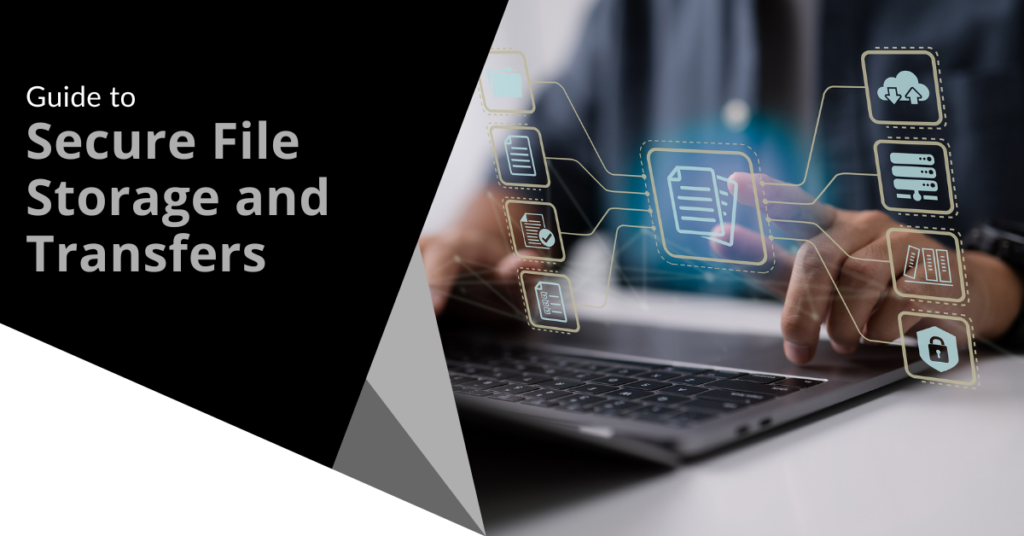|
Getting your Trinity Audio player ready...
|

Ultimate Guide to Secure File Storage and Transfer
Storing and transferring files safely is essential in today’s digital world. Unfortunately, maintaining secure file management can be quite challenging. In this comprehensive guide, we’ll help you protect your data by exploring effective ways to store and share files securely.
What Is Secure File Storage?
Secure file storage involves safeguarding your files from unauthorized access or alterations. It ensures that your data remains protected by using various security measures, such as encryption or password protection. With secure file storage, only authorized users can unlock and access your information.
Preventing Phishing Attacks
Phishing attacks are a common threat to data security. These attacks trick you into revealing sensitive information through fake messages or deceptive websites. To protect your files, always verify the sender’s email address and avoid clicking on suspicious links.
Types of Secure File Storage
There are multiple methods to store files securely:
- Cloud Storage: Saves your data online, accessible from any device.
- External Hard Drives: Physical devices where you can store important files.
- Encrypted USB Drives: Uses encryption to lock your data, making it harder for unauthorized users to access.
Choosing the right file storage solution depends on your needs. Cloud storage is convenient for remote access, while external drives offer physical control. Encrypted USB drives add an extra layer of protection.
Why Is Secure File Storage Important?
Secure file storage helps keep your personal and professional data private. It prevents identity theft, financial loss, and privacy violations. By using secure file storage practices, you also comply with data protection regulations, minimizing potential legal issues.
Risks of Unsecured File Management
Failing to secure your files can result in:
- Identity Theft: Personal data can be stolen and misused.
- Financial Loss: Unauthorized access can lead to compromised financial details.
- Privacy Breaches: Sensitive information could be exposed.
These risks highlight the importance of maintaining secure file storage practices. Always take the necessary precautions to protect your files.
How to Enhance Your File Security
Implementing the following strategies can significantly improve the safety of your data:
- Strong Passwords: Create complex and unique passwords for each account.
- Two-Factor Authentication: Adds an extra step for accessing your files.
- Encryption: Protects files by converting them into unreadable formats.
- Regular Updates: Keep your software up to date to address security vulnerabilities.
By adopting these practices, you ensure that your data remains robust against cyber threats.
Best Practices for Password Security
Here are some tips to create strong, reliable passwords:
- Use at least 12 characters, combining letters, numbers, and symbols.
- Avoid using personal information.
- Change passwords regularly.
- Do not reuse the same password across different accounts.
Adhering to these practices can make unauthorized access significantly more challenging.
What Is Secure File Transfer?
Secure file transfer refers to transmitting files between devices without exposing them to unauthorized access. This process ensures that data remains protected during transit by employing encryption and secure transfer protocols.
Secure File Transfer Methods
Here are some reliable methods for secure file transfer:
- SFTP (Secure File Transfer Protocol): Encrypts data during upload and download.
- VPN (Virtual Private Network): Protects data transfer over public networks.
- Encrypted Email Attachments: Safeguards files while sharing via email.
- Secure File-Sharing Platforms: Offers end-to-end encryption.
These methods ensure that your data is shielded from prying eyes while in transit.
How to Transfer Files Safely
Follow these steps to ensure secure file transfer:
- Choose a secure transfer method.
- Encrypt files before sending.
- Use strong authentication for file access.
- Verify the recipient’s identity.
- Share access details separately from the file itself.
By applying these strategies, you enhance the safety of your file transfers.
Secure Email Attachment Tips
Email attachments can be risky. Here are ways to mitigate the risks:
- Encrypt attachments before sending.
- Use a secure email provider.
- Do not include sensitive information in the email body.
- Double-check the recipient’s email address.
Taking these precautions can prevent unauthorized access through email vulnerabilities.
Avoiding Common File Storage Mistakes
Many people inadvertently put their data at risk by:
- Using weak passwords.
- Failing to encrypt sensitive files.
- Relying on public Wi-Fi for file transfers.
- Neglecting software updates.
- Sharing access credentials directly with files.
Tips to Avoid These Mistakes
To keep your file storage secure, consider the following:
- Utilize a password manager for stronger security.
- Set up automatic encryption for your files.
- Always use a VPN on public networks.
- Enable automatic updates to patch vulnerabilities.
- Share passwords separately from the files.
By avoiding these errors, you reduce the risks associated with insecure file storage.
Take Charge of Your File Storage Today!
Securing your file storage not only protects your personal information but also reduces the risk of cyberattacks. Implement strong security measures, including password protection and encryption, and be mindful of secure file transfer practices.
Need guidance on enhancing your file storage security? Contact us today to learn more about setting up secure systems for your critical data. Don’t wait until it’s too late—take proactive steps to safeguard your files now.
Twintel has grown into an expansive, full team of IT services professionals, acting as the outsourced IT department of non-profits, small to mid-size businesses, and enterprise-level corporations in Orange County, across California, and nationally.
Today, it’s the strength and deep expertise of the Twintel team that drives positive outcomes for clients. Each of the support staff, technicians, and engineers works diligently each day to make sure that the companies served have the seamless, secure, and stable IT environments needed to allow them to pursue their organizational objectives.